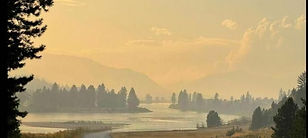
Cabinet Mountain Valley
Plains, Montana


Clark Fork River Valley
Plains, Montana
Climate Options
The Earth in 300 Years
Option One
Adapting to Climate Change
To envision the Earth in 300 years by adapting to climate change, consider these potential developments:
Climate Change Adaptation: Coastal cities can implement advanced flood defenses and sustainable architectural designs.
Renewable Energy Dominance: A significant shift to solar, wind, and other renewable sources could power most of the globe.
Biodiversity Restoration: Efforts to restore ecosystems and protect endangered species may lead to healthier biodiversity.
Urbanization Trends: Smart cities with integrated technology could enhance living conditions and reduce environmental impact.
Space Colonization: Human presence on Mars or the Moon might be established, with potential for resource extraction.
Technological Integration: AI and automation have the potential to transform industries, with significant implications for employment and daily life.
Global Governance: International cooperation may intensify to address global challenges such as pandemics and climate change.
Genetic Engineering: Advances in biotechnology could lead to enhanced health and longevity for humans.
Water Scarcity Solutions: Innovative desalination and water recycling technologies may alleviate water shortages.
Cultural Evolution: Global cultures may blend, resulting in new social norms and values shaped by technology and increased connectivity.
———————————————————

The Earth in 300 Years
Option Two
No Adoption for Climate Change
To envision the impact of climate change on Earth in 300 years, consider these potential developments:
Rising Sea Levels: Coastal cities may be submerged due to significant ice melt and thermal expansion of oceans.
Extreme Weather Events: Increased frequency and intensity of hurricanes, droughts, and heatwaves could disrupt ecosystems and human life.
Biodiversity Loss: Many species may face extinction as their habitats change or disappear, resulting in reduced biodiversity.
Agricultural Shifts: Crop yields may decline in some regions while others become more viable, altering global food distribution.
Human Displacement: Millions may be forced to migrate due to uninhabitable conditions, leading to climate refugees.
Health Risks: Increased heat and pollution could exacerbate health issues, including respiratory diseases and heat-related illnesses.
Water Scarcity: Freshwater resources may dwindle, leading to conflicts over access to and management of water.
Economic Disruption: Industries that rely on stable climates, such as agriculture and tourism, may face severe financial challenges.
Technological Adaptations: Innovations in renewable energy and carbon capture could emerge as critical solutions to mitigate impacts.
Global Cooperation: Nations may need to collaborate more closely to address climate challenges and implement sustainable practices.
———————————————————